|
|
 |
|
Calanoida ( Order ) |
|
|
|
Arietelloidea ( Superfamily ) |
|
|
|
Heterorhabdidae ( Family ) |
|
|
|
Heterorhabdus ( Genus ) |
|
|
| |
Heterorhabdus spinifer Park, 1970 (F,M) | |
| | | | | | | Syn.: | Heterorhabdus (Heterorhabdus) spinifer : Bradford-Grieve,1999 b (p.86, figs.F,M, Rem., figs.175, 191) | | | | Ref.: | | | Park, 1970 (p.477, 519, figs.F,M); Bradford, 1971 a (p.129); Bowman, 1971 b (p.44, Rem.); Park, 2000 (p.108, figs.F,M, Rem.); Vives & Shmeleva, 2007 (p.307, figs.F,M, Rem.) | 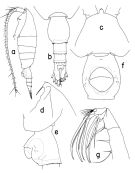 issued from : T. Park in Bull. Scripps Inst. Oceanogr. Univ. California, San Diego, 2000, 31. [p.228, Fig.76]. Female: a, habitus (left side); b, urosome (dorsal); c, d, forehead (dorsal, left, respectively); e, f, genital somite (left, ventral, respectively); g, left Mx2 (posterior). Nota: Prosome length 71 % length of body and about 2.3 times length of urosome. Forehead produced anteriad into a small spiniform process and ventrad into a small rostrum bearing 2 slender filaments. - Mx2 falcate spine (fig.76 g) of 5th lobe with proximal 68 % of medial margin serrated with spinules; falcate spine of 6th lobe with proximal 73 % of medial margin serrated with spinules. (Compare with H. prolatus fig.79 a and H. guineanensis fig.72 i).
|
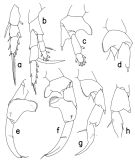 issued from : T. Park in Bull. Scripps Inst. Oceanogr. Univ. California, San Diego, 2000, 31. [p.229, Fig.77]. Female: a, exopod of P1 (anterior); b, P5 (anterior). Male: c, right P5 (with exopod omitted), anterior; d, basipod of left P5 (anterior); e, exopod of right P5 (anterior); f, right P5 (with endopod omitted), posterior; g, left P5 (with endopod omitted), anterior; h, exopod of left P5 (anterior).
|
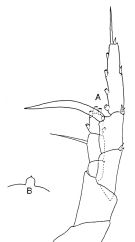 issued from : J.M. Bradford-Grieve in The Marine Fauna of New Zealand: Pelagic Calanoid Copepoda. National Institute of Water and Atmospheric Research (NIWA). NIWA Biodiversity Memoir, 111, 1999. [p.86, Fig.54]. Female: A, P5. Male: B, forehead (dorsal).
|
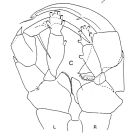 issued from : J.M. Bradford-Grieve in The Marine Fauna of New Zealand: Pelagic Calanoid Copepoda. National Institute of Water and Atmospheric Research (NIWA). NIWA Biodiversity Memoir, 111, 1999. [p.86, Fig.54]. Male: C, P5 (L = left leg; R = right leg)
|
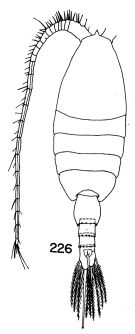 Issued from : T. S. Park in Bull. Mar. Sc., 1970, 20 (2). [p.518, Fig.226]. Female (from Caribbean Sea & G. of Mexico): 226, habitus (dorsal). Nota: Head and 1th toracic segment separate, 4th and 5th fused. Caudal rami asymmetrical, left larger with 2nd median seta thick and elongated.
|
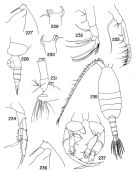 Issued from : T. S. Park in Bull. Mar. Sc., 1970, 20 (2). [p.520, Figs.227-237]. Female: 227, forehead (lateral); 228, posterior part of metasome and urosome (lateral left side); 229, right Md (biting edge of the mandibular blade); 230, left Md (idem); 231, Mx1; 232, Mx2; 233, Mxp; 234, P1 (anterior). Nota: Anterior forehead produced into a sharp point. mx1: 2nd inner lobe and basis each with 1 seta; endopod with 3 setae. Male: 235, habitus (dorsal); 236, forehead (lateral); 237, P5 (anterior). Nota: Left A1 geniculated. Mouthparts and P1-P4 as in female. P5: basis with a lamelliform inner process fringed with hairs, the process on right basis much higher; 2nd exopodal segment of right P5 with a large, characteristic inner projection.
|
 Heterorhabdus spinifer Heterorhabdus spinifer female: 1 - See key to species groups of Heterorhabdus: ''papilliger'' Group (p.90, 102). 2 - Midanterior tubercular process of forehead produced into a spiniform process (Fig.76-d).P5 without inner marginal seta on 1st endopodal segment (Fig.77-b).
|
 Heterorhabdus spinifer Heterorhabdus spinifer male: 1 - See key to species groups of Heterorhabdus: ''papilliger'' Group (p.90, 102). 2 - Midanterior tubercular process of forehead produced into a spiniform process. Basal inner lobe of left P5 large, rounded distally (Fig.77-g).
| | | | | Compl. Ref.: | | | Deevey & Brooks, 1977 (p.256, tab.2, Station "S"); Carter, 1977 (1978) (p.36); Schnack-Schiel & al., 2010 (p.2064, Table 2: E Atlantic subtropical/tropical); Medellin-Mora & Navas S., 2010 (p.265, Tab. 2) | | | | NZ: | 7 | | |
|
Distribution map of Heterorhabdus spinifer by geographical zones
|
| | | | | | | | |  Chart of 1996 Chart of 1996 | |
| | | | Loc: | | | South Africa (E & W), off NE Tristan da Cunha, Caribbean Sea, Caribbean Colombia, G. of Mexico, off Bermuda (Station "S"), Sargasso Sea, off Delaware, W Medit. (in Kovalev & Shmeleva, 1982, p.84), Natal, S Indian (E-W), S Pacif. tropical (E-W), off NE New Zealand.
Locality type: Caribbean Sea and Gulf of Mexico.
For Park (2000, p.109)The species has a circumglobal distribution. In the Indo-Pacific, the species seems to be restricted mainly to the southern tropical regions, while it occurs widely in the Atlantic. | | | | N: | 9 | | | | Lg.: | | | (88) F: 1,72-1,58; M: 1,72-1,6; (399) F: 1,8; M: 1,75; (824) F: 1,9-1,6; M: 2,02-1,64; {F: 1,58-1,90; M: 1,60-2,02} | | | | Rem.: | epi-meso-bathypelagic. Sargasso Sea: 0-1500 m (Deevey & Brooks, 1977, Station "S");
For park (1970, p.523) this species is related to H. spinifrons (Claus) and H. subspinifrons Tanaka. In anatomical details of appendages, the present species is closely related to H. papilliger (Claus), except for P5 (in spinifer the female has no setae on the 1st endopodal segment, and the male has a characteristic internal projection on the 2nd exopodal segment of the right leg). | | | Last update : 14/06/2022 | |
|
|
 Any use of this site for a publication will be mentioned with the following reference : Any use of this site for a publication will be mentioned with the following reference :
Razouls C., Desreumaux N., Kouwenberg J. and de Bovée F., 2005-2025. - Biodiversity of Marine Planktonic Copepods (morphology, geographical distribution and biological data). Sorbonne University, CNRS. Available at http://copepodes.obs-banyuls.fr/en [Accessed December 03, 2025] © copyright 2005-2025 Sorbonne University, CNRS
|
|
 |
 |









